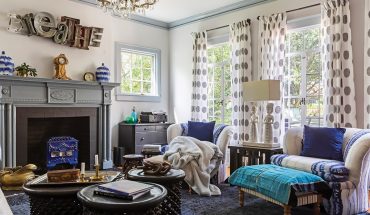
The pair of ultra-modern houses stands on an infill lot on Edenton St., four blocks from downtown. Robby Johnston’s firm, Raleigh Architecture Company, designed and built the homes on similar footprints, with a common courtyard. between them.
by J. Michael Welton
photographs by Juli Leonard
For newlyweds Roxanne Saucier and Nabarun Dasgupta, a post on Instagram in the fall of 2012 led not just to a new home, but to a new communal lifestyle in downtown Raleigh.
“It was a new-media type of encounter,” Dasgupta says.
The couple from Chapel Hill was scoping out homes with an architect friend in Oakwood and Mordecai when they posted a picture of themselves on the hunt. Almost immediately, Raleigh architect Robby Johnston, who knew the couple’s friend, responded with a post of his own.
“Robby reached out to our mutual friend and asked if we’d be interested in doing something with him,” Dasgupta says. “We met in person and he showed us models and diagrams and it went quickly from there.” The result wasn’t just a new house, it was two new ultra-modern houses – one for the clients, one for the architect. The pair now stands on an infill lot on Edenton Street, four blocks from downtown.

“Our stairs are about light – there are open risers and rails, with nothing solid to prohibit light coming into the house,” says architect Robby Johnston.

In Roxanne Saucier and Nabarun Dasgupta’s home, there are three different cabinet finishes, dark red-oak floors, and a solid ribbon of stairs that slashes through all three levels, tying them together.
Johnston’s firm, Raleigh Architecture Company, designed and built the homes on similar footprints, with a common courtyard between them. The 36-year-old architect now lives in one with his wife, Ryan, and their two daughters, aged three and five. Saucier and Dasgupta live in the other with their two-year-old son. They’re all friends.
“That was one of the attractions for us – here was a young professional couple our age and with similar values,” Dasgupta says. “We didn’t know anyone in Raleigh, so it was a built-in social network.”
The big idea was to build homes and friendships above the double lot that Ryan had discovered in 2011. “We’ve only gotten to be better friends because we spend time together,” she says. “We made an agreement that if we ever sell, we’ll screen potential buyers with each other.”
Their sense of community revolves around that 1,200-square-foot shared courtyard. Each couple owns 50 percent of the space, and there’s still a property line. “If we sell tomorrow, someone could put a fence there,” Johnston says. “But we agreed from the beginning that we’d be there a long time.”

Robby Johnston’s expansive use of natural light and choice of materials, including the kitchen’s gray-and-white quartz counters and IKEA cabinetry with white-oak floors, make the 1,700-square-feet home feel much larger.
The courtyard’s design is a minimalist work of art by local landscape architect Corey Mason. His master plan called for enough structure for the space to feel organized, while also celebrating its roots in nature. “We were creating a space for outdoor dining, a lawn for the kids, and a boardwalk out front,” Mason says. “It’s a pastoral landscape that’s like being within a meadow – despite being in the middle of the city.”
Mason holds a graduate degree in landscape architecture from Texas A&M. He cites influences from California master landscape architect Bernard Trainor, as well as Piet Oudolf, who worked on the High Line in New York City and Millennium Park in Chicago. On Edenton Street, Mason used a light touch, piercing the courtyard’s rectangular green lawn vertically with five European hornbeam trees. Eventually, they’ll reach up 30 feet. As they grow, the families may choose to intertwine the trees’ branches – a French practice called pleaching – in a subtle suggestion about the nature of their shared relationships over time.
The landscape, Mason says, is meant to reflect Johnston’s designs, with straight lines breaking up the courtyard into different sections and rooms. “He thinks spatially about the landscape like we do about architecture,” Johnston says.
Johnston’s own work recalls its Raleigh precedents, including designs by the late N.C. State modernist Harwell Harris, and current practitioners Frank Harmon and Vinny Petrarca. “Harris was clearly one the of major players here,” Johnston says. “Frank learned from him, Vinny learned from Frank, and I learned from Vinny.”

A view of Roxanne Saucier and Nabarun Dasgupta’s balcony from Robby Johnston’s home. Each house has ample views through carefully-placed windows and balconies on different levels.

A model of Roxanne Saucier and Nabarun Dasgupta’s home sits on a kitchen window sill overlooking the shared courtyard that is co-owned by both families.
Harris had worked in the 1920s and ’30s for the Austrian-born American architect Rudolph Schindler and his California partner, Richard Neutra, as they boldly explored the boundaries of modern design. So Johnston’s two homes on Edenton Street are about more than just their Carolina heritage; they’re also thoughtful answers to questions about form and space, opacity and transparency in modern architecture.
“One is a three-story solution and one needed a two-story solution,” Johnston says. “Then there’s the yard that adults use as adults and kids use as kids.” Windows, he says, are placed carefully so that kitchen and dining spaces in both houses connect to the outdoors.
The light that reaches deep inside and the views that look out are defining characteristics of both homes, but each expresses its owner’s style. “The houses are fraternal twins – we can be a lot alike but we also can be different,” he says. “We know they’re similar and share characteristics, but they also express our personalities and the way we want to live in this environment.”
Johnston’s house, 1,700 square feet over two levels, actually feels much larger than its neighbor’s 2,300-square-foot home on three. It’s an effect produced by the architect’s expansive use of natural light and choice of materials, including the kitchen’s gray-and-white quartz counters and IKEA cabinetry, with white-oak floors. “I have a very neutral palette,” he says. “Our stairs are about light – there are open risers and rails, with nothing solid to prohibit light coming into the house.”
The house across the courtyard has the same number of windows, but feels more opaque. There are three different cabinet finishes, dark red-oak floors, and a solid ribbon of stairs that slashes through all three levels, tying them together.
“For Nab and Roxanne, because they’re working on the third floor and cooking on the first, the stairs between are about experiencing that space,” Johnston says. “We both made conscious decisions – we wanted to be more open and they wanted to be more comfortable.”
Outside finishes are also as different as day and night, though they do share a partial cladding of Carolina cypress, harvested and milled in-state. Johnston’s home employs repurposed slate shingles salvaged from older buildings, while his neighbors selected a weathering Corten steel that oxidizes over time. “They chose a material that didn’t have a history, but would develop one,” Johnston says. “As they change, the house changes.”
His clients say the entire design/build experience was enriching. “It was one of the coolest creative processes we’ve ever been through,” Dasgupta says. “It was a process where the marriage got stronger – it made us stronger as a family.”
That’s a testament to the power of good architecture – and the serendipitous nature of social media.






